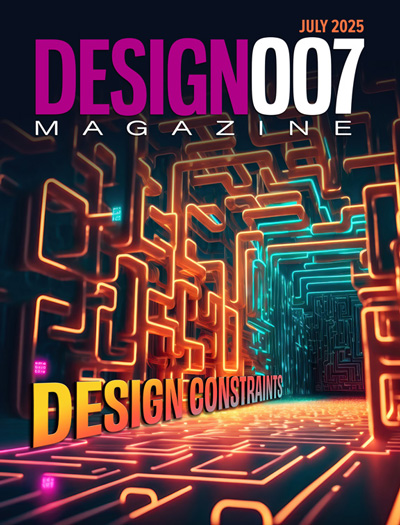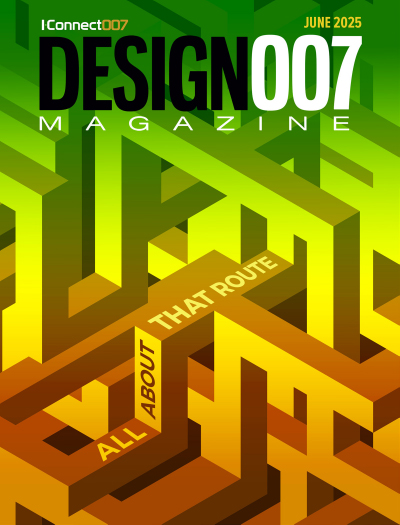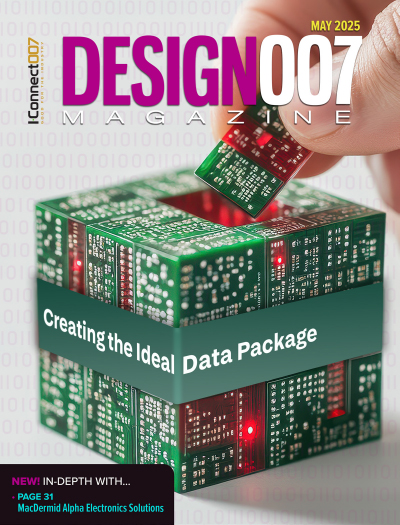-

- News
- Books
Featured Books
- design007 Magazine
Latest Issues
Current Issue
Showing Some Constraint
A strong design constraint strategy carefully balances a wide range of electrical and manufacturing trade-offs. This month, we explore the key requirements, common challenges, and best practices behind building an effective constraint strategy.

All About That Route
Most designers favor manual routing, but today's interactive autorouters may be changing designers' minds by allowing users more direct control. In this issue, our expert contributors discuss a variety of manual and autorouting strategies.

Creating the Ideal Data Package
Why is it so difficult to create the ideal data package? Many of these simple errors can be alleviated by paying attention to detail—and knowing what issues to look out for. So, this month, our experts weigh in on the best practices for creating the ideal design data package for your design.
- Articles
- Columns
- Links
- Media kit
||| MENU - design007 Magazine
Driving Sustainability in PCB Design
April 24, 2025 | Marcy LaRont, I-Connect007Estimated reading time: 4 minutes
Filbert (Fil) Arzola is an electrical engineer at Raytheon. He’s smart, entertaining, and passionate about PCB design. As it turns out, he’s also passionate about “Mother Earth,” as he calls her. Born and raised in Southern California, he freely admits that he turns the water off when he brushes his teeth and yells at his brother for throwing batteries in the garbage. But when looking at the issue of sustainability and PCB design—and, more broadly, the manufacture and disposal of electronic devices—he urges his audiences to ponder what sustainability looks like. Can PCB designers, he asks, make any impact on sustainability at all?
At IPC APEX EXPO, Fil addressed this topic in his Professional Development Courses presentation, “Adapting and Engineering Model-Based PCB Design in Step with Sustainability and Digital Twin.”
“We constantly want more and more in our technology. So how can technology be sustainable?” he asked. Enter “digital twin,” and a “make it right the first time” approach making multiple build revisions of PCBs unnecessary.
Fil provided a working definition of sustainability for PCB design as “a technical effort to save design production schedule, materials and assembly while reducing labor costs and waste,” stating, “This is how we do sustainability in PCB design. Today, we can build using digital twin and build 10 boards instead of hundreds of boards.”
Though resistance to investment in the software and tools required to create things like digital twins solely for the sake of sustainability are consistently raised by most companies, Fil says we simply can’t afford to. Fil’s focus was on creating a mindset of awareness and a thoughtful consideration of looking at all products that we build and consume in terms of sustainability, from design to product use to landfill—if that is their unfortunate destination (which it usually is).
“Material selection is the main driver for responsible design sustainability,” Fil said about PCB design. To be more environmentally sustainable, he says we need to have a default for rigid laminate and FR-4 (epoxy) material. He ranked the different material types, from polyimide to PTFE to flex, by cost. Raytheon, he said, has tried to stick to the same board material for all that they do to be more sustainable when it comes to cost, supply chain, and time.
Fil talked about vias, submitting that the more vias a board design has, the more drill bits the fabricator will go through, which is not as environmentally sustainable. “The point is, if you have vias on your board, use them wisely,” he said. “If you can use a 1 to 4 via instead of a 1 to 6 and save drill bits, do that.” Of course, this takes some knowledge of the PCB fab process, and again, a sensitivity toward a much bigger picture when designing a PCB. He also mentioned designing for assembly with chips that you are able to remove instead of scrapping an entire board if the chip is bad. It’s more sustainable both in use of materials and it saves a lot of money. Of course, swapping chips out may not be on the table, but it is worth asking the question and being fully aware of the options.
This presentation taught me that Fil is something an environmental sustainability activist. Though he seems to have an outdated idea of how dirty PCB shops are (a personal pet peeve), I admire that he aims to make meaningful changes in electronics manufacturing. Working in the very traditional mindset of the aerospace industry, the endeavor to make change cannot an easy one to fulfill. He says he is committed to changing mindsets and making meaningful change in electronics manufacturing. He wants to use his voice and his knowledge, and maybe even his money, if it comes down to it.
In a sidebar, Fil mentioned that he has been fortunate to have four great bosses, the first of whom told him emphatically that he wouldn’t just design boards, but he would learn everything he could about mechanical and thermal engineering. This has served him well for his entire career and has also helped him to see the process more holistically and completely.
As he wrapped up this presentation, Fil noted that the U.S. is way behind in its sustainability efforts in comparison to our European counterparts, and reminded the audience that it really is up to them, as designers, to make change happen by using their voices. A few of the suggestions he gave to do this included: “Think inside the box,” “Develop and unite in parallel electrical and mechanical model integration,” and “Drive responsible sustainable design engineering guidelines into their PCB design methodologies now.”
Testimonial
"Our marketing partnership with I-Connect007 is already delivering. Just a day after our press release went live, we received a direct inquiry about our updated products!"
Rachael Temple - AlltematedSuggested Items
Setting Design Constraints Effectively
07/31/2025 | Stephen V. Chavez, Siemens EDAPCB design requires controlling energy within the medium of a PCB. The manner in which we control the chaos of energy is by implementing and utilizing physical and electrical rules, known as constraints, along with a specific structure and material(s) that make up what is known as the foundation of the design. These rules govern everything within the PCB structure and generally fall into two camps: performance and manufacturability. Setting this foundation correctly is extremely important and the key to success.
MacDermid Alpha Electronics Solutions Unveils Unified Global Website to Deepen Customer, Talent, and Stakeholder Engagement
07/31/2025 | MacDermid Alpha Electronics SolutionsMacDermid Alpha Electronics Solutions, the electronics business of Elements Solutions Inc, today launched macdermidalpha.com - a unified global website built to deepen digital engagement. The launch marks a significant milestone in the business’ ongoing commitment to delivering more meaningful, interactive, and impactful experiences for its customers, talent, and stakeholders worldwide.
Ansys 2025 R2 Enables Next-Level Productivity by Leveraging AI, Smart Automation, and Broader On-Demand Capabilities
07/30/2025 | PRNewswireAnsys, now part of Synopsys, announced 2025 R2, featuring new AI-powered capabilities across the portfolio that accelerate simulation and expand accessibility.
Connect the Dots: Sequential Lamination in HDI PCB Manufacturing
07/31/2025 | Matt Stevenson -- Column: Connect the DotsAs HDI technology becomes mainstream in high-speed and miniaturized electronics, understanding the PCB manufacturing process can help PCB design engineers create successful, cost-effective designs using advanced technologies. Designs that incorporate blind and buried vias, boards with space constraints, sensitive signal integrity requirements, or internal heat dissipation concerns are often candidates for HDI technology and usually require sequential lamination to satisfy the requirements.
Target Condition: The 5 Ws of PCB Design Constraints
07/29/2025 | Kelly Dack -- Column: Target ConditionHave you ever sat down to define PCB design constraints and found yourself staring at a settings window with more checkboxes than a tax form? You’re not alone. For many designers—especially those newer to the layout world—the task of setting up design constraints can feel like trying to write a novel in a language you just started learning.


